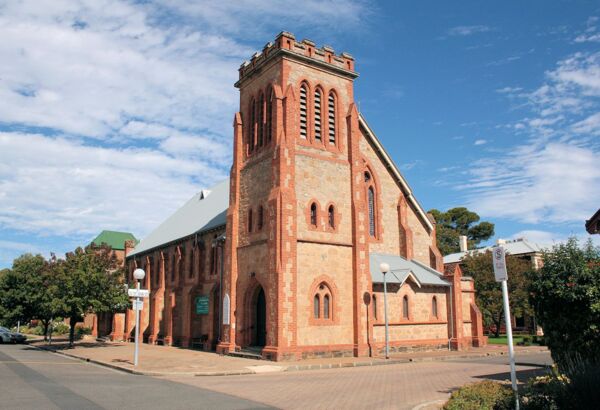Adelaide, SA - St John the Evangelist Anglican
Year Built: 1839
Denomination: Anglican
Saint: John the Evangelist
Address: 14 St John Street, Adelaide, South Australia, 5000
Architect: R. Garlick Holwell
Traditional Owners: Kaurna people
Last Updated: 12/07/2024
History and Architecture:
The land on which the church is built was donated by Osmond Gillies to the Church of England. The Foundation stone was laid on 19 October 1839 by Lieutenant Colonel George Gawler, Governor of the Province. The church was opened on Sunday, 24th October, 1841 by the Rev C.B. Howard assisted by the Rev Jas. Farrell.
In 1886 the original church was condemned by the City Surveyor.
Plans for a new church were prepared by the architect R G Holwell. William Rogers who was a notable builder in Adelaide built the Church. The walls were constructed of sandstone rubble and are unusually tuck-pointed. The tower which still dominates the residential area integrates well with the rest of the church and its angled buttresses are noteworthy. The Bishop of Adelaide laid the Foundation Stone on May 14 1887 and on October 6th of the same year consecrated the building.
Clergy:
This list may not contain every serving cleric, past or present, for this church.
Further submissions welcomed.
| Years | Name | Annotation | D.o.B | D.o.D |
|---|---|---|---|---|
| 1841 - 1861 | Rev James Farrell | 1803 | ||
| 1861 - 1884 | Rev D J.H. Ibbetson | |||
| 1874 - 1895 | Rev Frederick Slaney | 1845 | 1936 | |
| 1895 - | Rev W. S Hopcraft | |||
| 1918 - | Rev H P Finniss | |||
| 1945 - | Rev E. J. Cooper | |||
| 1978 - 1980 | Rev Neville Allan Connell | 1938 | ||
| 2019 - | Rev Stephen Bloor |
Organ:
The first Organ was built by Samuel Marshall in 1848, and its now at St Aidan’s Church, Payneham. The second organ was built by J.W. Wolff in 1875 and enlarged by Fincham & Hobday in 1888. The present organ was built by J.E. Dodd 1901 and rebuilt in 1965 by J.E. Dodd & Sons Gunstar Organ Works Restored in 1996 by George Stephens Pty Ltd. It has 2 manuals, 21 speaking stops, 5 couplers, mechanical action
For a full history and photos click here.
Source:
1. Organ Historical Trust of Australia with permission.
